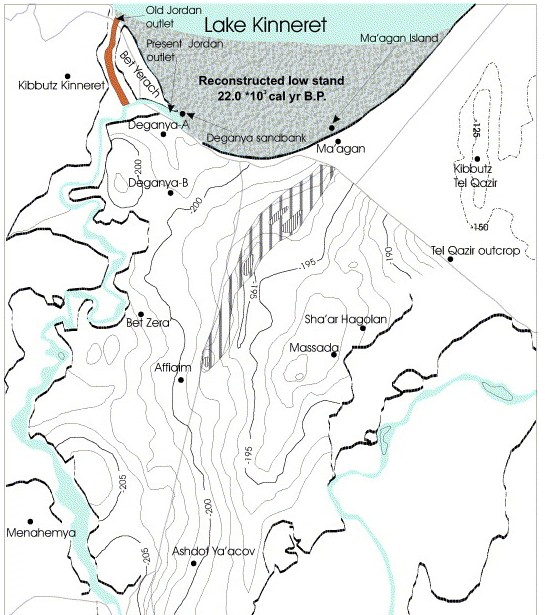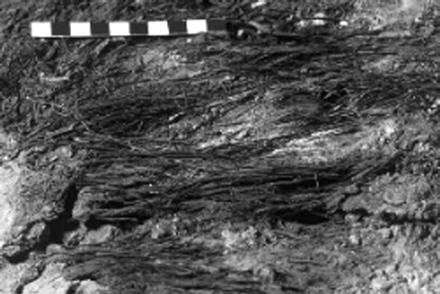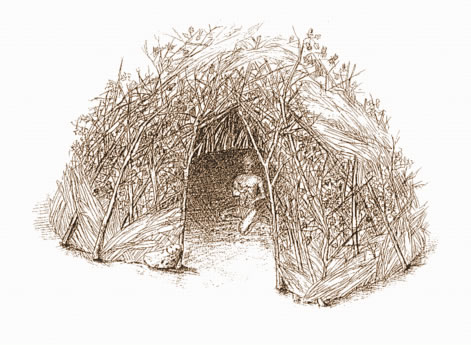It looks like you're using an Ad Blocker.
Please white-list or disable AboveTopSecret.com in your ad-blocking tool.
Thank you.
Some features of ATS will be disabled while you continue to use an ad-blocker.
share:
Ohalo II is the name of a previously submerged late Upper Paleolithic site on southwest shore of the Sea of Galilee or Lake Kinneret. It reflects the
Kebaran culture and containing the floors and wall bases of six oval brush huts, six open-air hearths and a human grave. Much of the soft materials
survived, since it had been submerged, it provided very rare evidence of food sources for late Upper Paleolithic habitation sites.
Link to a general summary about the the site
Location of Ohalo II

A site drawing of the site

Detail map of the southern area of lake Galilee

At the dig where you can see the receded shore line

Side diagram of the site

The preserved bedding

PDF on the bedding discovered at Ohalo II
Reconstruction of a hut at Ohalo II

PDF on the human remains found at Ohalo II
PDF on the grains and fibre's found at the site
PDF on wooden objects found at the site
Link to a site that briefly covers what they ate at Ohalo II
Animals represented by bones in the faunal assemblage include fish, tortoise, birds, hare, fox, gazelle, and deer.
Link to a general summary about the the site
Location of Ohalo II

A site drawing of the site

Eight wooden objects were found at Ohalo II, a submerged and well-preserved site in the Sea of Galilee, Israel. The fisher-hunter-gatherers' site has been radiometrically dated to 22,500-23,500 (cal BP) with 45 assays read by four laboratories. One incised wooden object is identical in size and incision pattern to a gazelle bone implement found in a grave, behind a human skull. The recovered wooden objects are not directly related to hunting, gathering, or fishing, and frustratingly, there are no remains of bows, arrows, spears, handles, or other such items. Nonetheless, the objects present a wide repertoire in terms of size, shape, and possible function. The new finds add to the growing body of evidence concerning the use of perishable materials during the Upper Paleolithic.
Detail map of the southern area of lake Galilee

At the dig where you can see the receded shore line

Side diagram of the site

The preserved bedding

PDF on the bedding discovered at Ohalo II
Reconstruction of a hut at Ohalo II

PDF on the human remains found at Ohalo II
PDF on the grains and fibre's found at the site
PDF on wooden objects found at the site
Link to a site that briefly covers what they ate at Ohalo II
edit on 27/11/12 by Hanslune because: (no reason given)
reply to post by Hanslune
Excellent info pal.
So, if I am not mistaken, this would bring the Introduction of Agriculture, to the beginnings of Farming as cultural lifestyle.
Or so I take it anyways.
I like the finding of the seeds. I guess the introduction of dampness had the same effect as peat in preserving these plants.
Makes me wonder it any materials can be used from the "found" seed assortment. Genetics to constuct better food maybe??
Ciao
Shane
Excellent info pal.
So, if I am not mistaken, this would bring the Introduction of Agriculture, to the beginnings of Farming as cultural lifestyle.
Or so I take it anyways.
I like the finding of the seeds. I guess the introduction of dampness had the same effect as peat in preserving these plants.
Makes me wonder it any materials can be used from the "found" seed assortment. Genetics to constuct better food maybe??
Ciao
Shane
reply to post by Hanslune
S & F
Great find.
23,000 years ago, now we are talking.
I'd like to see a facial reconstruction done from the skulls
S & F
Great find.
23,000 years ago, now we are talking.
I'd like to see a facial reconstruction done from the skulls
Originally posted by Shane
reply to post by Hanslune
Excellent info pal.
So, if I am not mistaken, this would bring the Introduction of Agriculture, to the beginnings of Farming as cultural lifestyle.
Or so I take it anyways.
I like the finding of the seeds. I guess the introduction of dampness had the same effect as peat in preserving these plants.
Makes me wonder it any materials can be used from the "found" seed assortment. Genetics to constuct better food maybe??
Ciao
Shane
Interesting idea I don't know whether they did DNA tests of the seeds however this excavation occurred before the big technological leap in DNA and I don't know if the have done any retro testing.
From what we know this was before the advent of agriculture these dudes still seemed to have been 'gathering'
reply to post by Hanslune
Sorry for my off topic post earlier, my point wasn't to derail the thread, on the contrary I wanted to add some laughs and I failed
On topic.
Thank you for the info and the time you took to make the thread, 23 000 years gives us a great insight into ancient
peoples and their way of life
S&F
SS
Sorry for my off topic post earlier, my point wasn't to derail the thread, on the contrary I wanted to add some laughs and I failed
On topic.
Thank you for the info and the time you took to make the thread, 23 000 years gives us a great insight into ancient
peoples and their way of life
S&F
SS
Great thread, Hans.
You know it's old when you can download the pdf for free! LOL
No question about it, if it's true they were gathering these for food, it's not much more of a step to clear some land and plant them.
One of the papers linked says they were partially preserved by charring before they were covered in silt and mud (eventually.) Makes me think maybe they were making malt for scotch LOL.
The same pdf tells you that all but one of the grasses still grows abundantly in the area of the site.
Harte
You know it's old when you can download the pdf for free! LOL
Originally posted by Shane
reply to post by Hanslune
Excellent info pal.
So, if I am not mistaken, this would bring the Introduction of Agriculture, to the beginnings of Farming as cultural lifestyle.
Or so I take it anyways.
No question about it, if it's true they were gathering these for food, it's not much more of a step to clear some land and plant them.
Originally posted by Shane
I like the finding of the seeds. I guess the introduction of dampness had the same effect as peat in preserving these plants.
One of the papers linked says they were partially preserved by charring before they were covered in silt and mud (eventually.) Makes me think maybe they were making malt for scotch LOL.
Originally posted by ShaneMakes me wonder it any materials can be used from the "found" seed assortment. Genetics to constuct better food maybe??
The same pdf tells you that all but one of the grasses still grows abundantly in the area of the site.
Harte
Originally posted by SLAYER69
reply to post by Hanslune
S & F
Great find.
23,000 years ago, now we are talking.
I'd like to see a facial reconstruction done from the skulls
..........and recovered from a formerly flooded coast line,.... Okay a lake's coast line
Originally posted by Spike Spiegle
reply to post by Hanslune
Sorry for my off topic post earlier, my point wasn't to derail the thread, on the contrary I wanted to add some laughs and I failed
On topic.
Thank you for the info and the time you took to make the thread, 23 000 years gives us a great insight into ancient
peoples and their way of life
S&F
SS
No problem !
Originally posted by Harte
Great thread, Hans.
You know it's old when you can download the pdf for free! LOL
Yeah!! Freedom of information - its hard now to get info from behind paywalls. I have access to a University library but then I face the problem of not being able to show images or take quotes from it
The same pdf tells you that all but one of the grasses still grows abundantly in the area of the site.
I took it to mean that they used the grasses for bedding and a roof but not for eating
Originally posted by SLAYER69
I'd like to see a facial reconstruction done from the skulls
Why don't you email the leading archaeologist and ask?
reply to post by Harte
Well in honesty, I may have used the term Agricultural in an inappropriate manner.
I look at this from this perspective.
These peoples had dwellings which seemingly appear to be a constant residence, albeit a grass hut, and they seemed to be able to have a way of life, based upon their ability to have these various seeds for an early form of Farming, should the surrounding area be able to grow these plants. Throw in the management it appears they also had in the wildlife of the region and the ability to fish, and it all points to an Agri-lifestyle.
Primitive at best, but site specific nonetheless.
It is always nice to see our Past come alive.
Ciao
Shane
Well in honesty, I may have used the term Agricultural in an inappropriate manner.
I look at this from this perspective.
These peoples had dwellings which seemingly appear to be a constant residence, albeit a grass hut, and they seemed to be able to have a way of life, based upon their ability to have these various seeds for an early form of Farming, should the surrounding area be able to grow these plants. Throw in the management it appears they also had in the wildlife of the region and the ability to fish, and it all points to an Agri-lifestyle.
Primitive at best, but site specific nonetheless.
It is always nice to see our Past come alive.
Ciao
Shane
Originally posted by Shane
reply to post by Harte
Well in honesty, I may have used the term Agricultural in an inappropriate manner.
I look at this from this perspective.
These peoples had dwellings which seemingly appear to be a constant residence, albeit a grass hut, and they seemed to be able to have a way of life, based upon their ability to have these various seeds for an early form of Farming, should the surrounding area be able to grow these plants. Throw in the management it appears they also had in the wildlife of the region and the ability to fish, and it all points to an Agri-lifestyle.
Or, it appears that they migrated here to gather the ripening grain (assuming they ate it) and left for other spots with more food every year when the grain was gone (again, assuming they ate it.)
Pretty much equal as far as appearances go. Since there's no real evidence of actual agriculture, we are forced to assume the former and speculate about the latter.
Harte
reply to post by Harte
We'd have to wait awhile for agriculture but they obviously returned here as part of their resource cycle and there was probably a lot of these grasses growing in this area - why farm when its there? It took a smarter person to figure out the next step
We'd have to wait awhile for agriculture but they obviously returned here as part of their resource cycle and there was probably a lot of these grasses growing in this area - why farm when its there? It took a smarter person to figure out the next step
reply to post by Hanslune
That's fascinating stuff,
I wonder what the Jordan valley was like back then.
Do the human remains and the burnt shelters date the same?
It's cool we are seeing the pre-dawn of agriculture, I wonder if there was an intermediate period of horticulturalism as there was in Asia and the new world.
That's fascinating stuff,
I wonder what the Jordan valley was like back then.
Do the human remains and the burnt shelters date the same?
It's cool we are seeing the pre-dawn of agriculture, I wonder if there was an intermediate period of horticulturalism as there was in Asia and the new world.
Hanslune
Very interesting read i love this kind of find thank you for posting the thread..peace,sugarcookie1 S&F
Very interesting read i love this kind of find thank you for posting the thread..peace,sugarcookie1 S&F
Originally posted by punkinworks10
reply to post by Hanslune
That's fascinating stuff,
I wonder what the Jordan valley was like back then.
Do the human remains and the burnt shelters date the same?
It's cool we are seeing the pre-dawn of agriculture, I wonder if there was an intermediate period of horticulturalism as there was in Asia and the new world.
I don't know but that might make a good thread, the starting of horticulture across the various civilizations and cultures
reply to post by Hanslune
More like a good doctoral thesis,
I wonder how much climate variability has to do with that transition from horticulture to agriculture.
You know in the second to the last of the cited works of the bibliography, the abstract contains this statement,
The source,
archaeology.about.com.../XJ&zTi=1&sdn=archaeology&cdn=education&tm=700&f=22&tt=13&bt=0&bts=0&zu=http%3A//dx.doi.org/10.1073/pnas.11 13931109
It's the catastrophic stimulus that caught my eye, is that code for instant climate change caused by an extraterrestrial impact, in north America perhaps?
More like a good doctoral thesis,
I wonder how much climate variability has to do with that transition from horticulture to agriculture.
You know in the second to the last of the cited works of the bibliography, the abstract contains this statement,
The resilience of Younger Dryas foragers is better illustrated by a concept of adaptive cycles within a theory of adaptive change (resilience theory). Such cycles consist of four phases: release/collapse (Ω); reorganization (α),when the system restructures itself after a catastrophic stimulus through innovation and social memory—a period of greater resilience and less vulnerability; exploitation (r); and conservation (K), representing an increasingly rigid system that loses flexibility to change. The Kebarans and Late Natufians had similar responses to cold and dry conditions vs. Early Natufians and the Pre-Pottery Neolithic A responses to warm and wet climates
The source,
archaeology.about.com.../XJ&zTi=1&sdn=archaeology&cdn=education&tm=700&f=22&tt=13&bt=0&bts=0&zu=http%3A//dx.doi.org/10.1073/pnas.11 13931109
It's the catastrophic stimulus that caught my eye, is that code for instant climate change caused by an extraterrestrial impact, in north America perhaps?
Originally posted by Hanslune
Originally posted by punkinworks10
reply to post by Hanslune
That's fascinating stuff,
I wonder what the Jordan valley was like back then.
Do the human remains and the burnt shelters date the same?
It's cool we are seeing the pre-dawn of agriculture, I wonder if there was an intermediate period of horticulturalism as there was in Asia and the new world.
I don't know but that might make a good thread, the starting of horticulture across the various civilizations and cultures
We do have some materials in regards to this in Man's First Gardening Skills? Wheats, Rice and Grafting of crops are discussed in several regions.
We can see when deliberate growth was beginning.
I didn't get the impression these individuals would have been specifically nomadic. It appears to me, they inhabited an area abundant in Food sources. I would expect to find Fish Bones in Fishing Areas. Antelope in another, rice or wheat in another. Not all these varied items found within 1 site.
If they have it that good, in respects to, things to eat, I wouldn't be to eager to leave the area.
Ciao
Shane
new topics
-
'Proud Prophet' 12 Day Exercise Predicted Global Nuclear Catastrophe
World War Three: 1 hours ago -
Never say Never?
Science & Technology: 4 hours ago -
Lies lies lies, green energy is black.
The Gray Area: 11 hours ago
top topics
-
Lies lies lies, green energy is black.
The Gray Area: 11 hours ago, 10 flags -
Never say Never?
Science & Technology: 4 hours ago, 8 flags -
Ford Motor Company sold to Elon Musk
Ludicrous Online Lies: 15 hours ago, 1 flags -
'Proud Prophet' 12 Day Exercise Predicted Global Nuclear Catastrophe
World War Three: 1 hours ago, 0 flags
active topics
-
Biden pardons his son Hunter despite previous pledges not to
Mainstream News • 87 • : WeMustCare -
Never say Never?
Science & Technology • 19 • : SuiStoic -
Salvatore Pais confirms science in MH370 videos are real during live stream
General Conspiracies • 33 • : b0kal0ka -
Lies lies lies, green energy is black.
The Gray Area • 21 • : Flyingclaydisk -
Australia passes social media ban for children under 16
Social Issues and Civil Unrest • 18 • : lilzazz -
'Proud Prophet' 12 Day Exercise Predicted Global Nuclear Catastrophe
World War Three • 3 • : LetsGoViking -
Jaguar Rebrand Video Causes "WTF?" Moment - Seriously Weird
Automotive Discussion • 40 • : network dude -
Elon Musk to Make Games Great Again - XAI_GAMES Announcement Incoming.
Video Games • 23 • : KnowItAllKnowNothin -
James Webb Telescope Takes a Look at the Sombrero Galaxy
Space Exploration • 18 • : Dalamax -
Of course it was DEI
Dissecting Disinformation • 28 • : Dalamax

